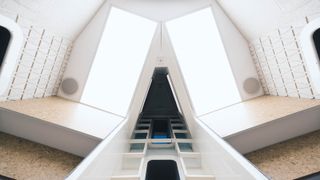Perched in a Swiss experimental park is a space habitat inspired by SpaceX’s Starship.
School-age students at the Institut auf dem Rosenberg, aged 6 to 18, worked for years on a prototype for future astronauts that would fit inside the hull of SpaceX’s mighty Starship rocket.
The results, unveiled on Wednesday July 20, show a luminous structure created in partnership with the Danish architecture firm SAGA Space Architects. The three-story building includes dedicated spaces for analog astronauts to work and relax.
Related: Bacteria recently discovered on the space station could help astronauts grow plants on Mars
In future years, students will follow “immersive learning modules” inside the habitat. They will work inside what would be the tallest 3D-printed polymer structure in the world at a height of 23 feet (7 meters), the institute said in a statement. (opens in a new tab) timed to coincide with the 53rd anniversary of the first human moon landing.
“Our goal is to provide future leaders with early exposure to the question of advanced space exploration, enabling our students to approach and solve…complex questions from a collaborative and holistic perspective,” Bernhard said. Gademann, managing director of Rosenberg. in the statement.
It took two years to create the Rosenberg Space Habitat from “initial creative concepts and paper models,” the institute said. Industry partners helped, with the 3D-printed outer shell created in Milan and the inner structure made in Copenhagen.
The use of polymers in 3D printing was a deliberate, yet somewhat unique, choice because “it offers more versatility than the concrete used in most 3D printed structures.” In anticipation of high ultraviolet (UV) radiation on the surface of the moon (opens in a new tab) or March (opens in a new tab), the material has a UV stabilizer to make it more durable. However, the habitat can also be broken down and the polymer reused to make a new structure if needed.
Add-ons for student missions include a robot, called Spot, and multi-functional furniture allowing residents to make the most of cramped quarters.
Planned investigations, Rosenberg said, will examine hardware, software, remote mission control systems and “sensory stimulation” including light, sound and smell. Students will also participate in projects designed to simulate “systems thinking” (how a complex system interacts between its parts) and work in artificial intelligence.
Rosenberg added that they hope internal investigations in their habitat will benefit future lunar explorers, as it will show students “not to fear new technologies, but to embrace and design them for the next generation.”
Follow Elizabeth Howell on Twitter (opens in a new tab). Follow us on twitter (opens in a new tab) Where Facebook (opens in a new tab).
 Jenam 2011
Jenam 2011
